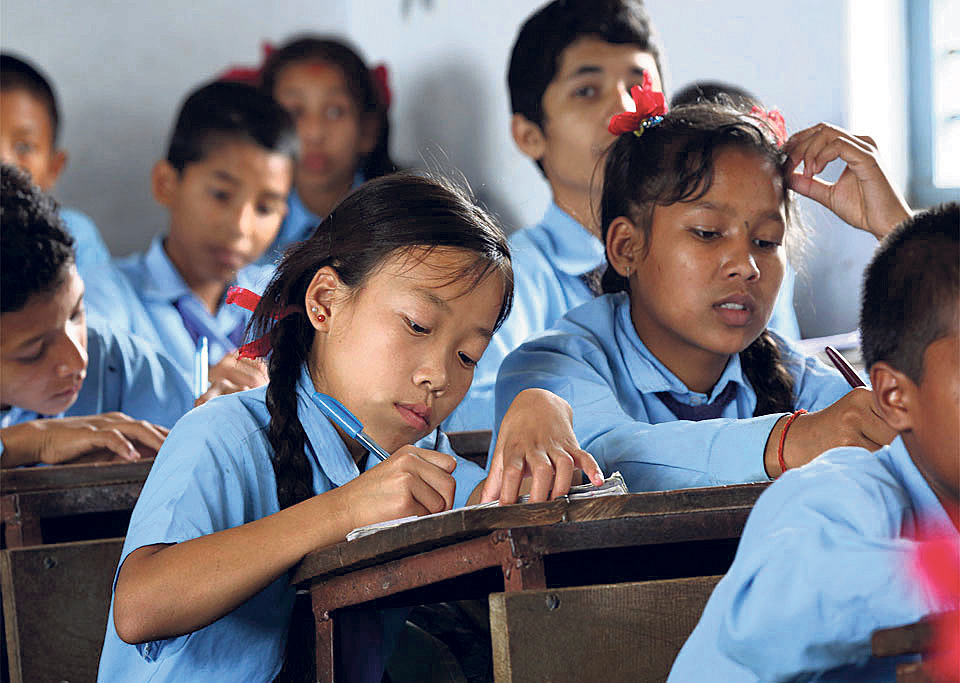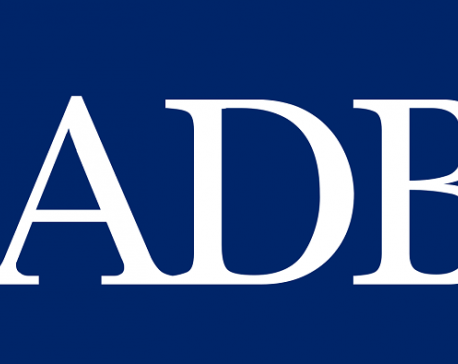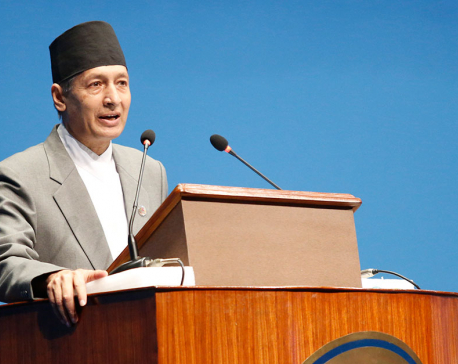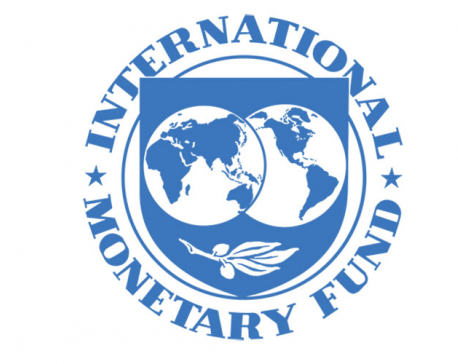
OR


Arun R Joshi
The author is Founder-Director of the Center for Human Development and Innovation, at the Institute of Integrated Development Studiesnews@myrepublica.com
More from Author
Unless Nepal swiftly and significantly invests in innovative and cost-effective education initiatives, we may be handing over a highly vulnerable and risky nation to the next generation
The future of our children and our nation is at risk. This is because learning achievement of our children is low and stagnant. The time to bask in the success of getting students enrolled in schools is over. Analyses show stronger positive association of economic growth with learning outcomes than with enrollment.
The Organization for Economic Cooperation and Development (OECD) recently published the Program for International Student Assessment (PISA) 2018 results that measure ‘15-year olds’ ability to use their reading, mathematics, science knowledge and skills to meet real-life challenges. Some 79 countries participated in the 2018 assessment and, once again, among the top performers are Singapore, Japan, Korea, China, Finland and Canada. These countries have also consistently performed at the top in other internationally benchmarked learning assessments such as the Trends in International Mathematics and Science Study (TIMSS) and the Progress in International Reading Literacy Study (PIRLS). These gold-standard assessments help to reliably compare performance across countries, and help participating countries to better understand areas of their strengths and weaknesses so that curricular and pedagogical adjustments can be made to improve the performance.
Nepal does not yet participate in any of these internationally benchmarked learning assessments. In the absence of a robust and regularly conducted national assessment system to improve student’s performance, Nepal’s National Assessment of Student Achievement (NASA) provides some insights into how well our children are learning. The fifth grade mathematics and Nepali assessments that were carried out at the start of 2018 showed that only 28 percent of students displayed adequate knowledge/skills in mathematics for that grade level and only 45 percent of students showed adequate knowledge/skills in Nepali. Wide variations in outcomes were evident across provinces and districts and between school types, among other variables. The assessment report noted that “the achievement and gap related results of NASA 2018 are quite similar to the results of NASA 2012 and 2015: The consistent recurring results….indicates that interventions were not sufficient in improving the quality of learning in the school level.”
Dismal outcome
Similarly, a USAID supported Early Grade Reading fluency assessment carried out in 2014 showed that only 12.8 percent of third graders could read relevant passages with fluency and comprehension and almost 20 percent could not read a single word of Nepali.
In the absence of adequate skills linking our youth to the demands of various economic sectors, it is no surprise that some 3.5 million youth are out of the country. And given the archaic higher education system, those who are better qualified are leaving the country for higher education and careers in foreign lands. What will be the consequence of having so many of our youth outside the country? How will this youth migration impact our human resource requirements in various sectors that need to grow as we move toward middle income status by 2030? We have yet to find answers to these important questions.
Low investment
Most high performing competitive countries have strong human development investment plans and strategies. While the strategies themselves might differ dramatically, three critical elements seem common. First, it is evident that these top performers started their investments in education from their early stages of development. For example, Singapore and Korea started investing significantly in education in the 1970s and 1980s, when their basic enrollment rates were less than ours today. Second, they are persistent investors, investing heavily in education even after they have attained a developed economic status. For example, a quick review of the Global Human Capital Report of the World Economic Forum 2017 shows that the top 10 countries’ average public expenditure on education was 6.25 percent of their GDP, as opposed to South Asian economies where the average was only 2.8 percent of their GDP.
Third, not surprisingly, these countries that are top performers in learning outcomes and top investors in human development are also those that are most competitive. Analysis shows that for every additional year of education, a person’s future income is increased by 10 percent, and at the national level, GDP is boosted by 18 percent.
Most competitive economies have emphasized the importance of investing in education and human development as a ‘national’ priority. It is usually a key agenda supported by the President or Prime Minister and extends across various ministries and local governments, non-profits and the private sector. Singapore’s Lee Kuan Yew once said: “Just as a country is as good as its citizens, so its citizens are, really, only as good as their teachers.” This statement illustrates the depth of the nation’s commitment to education in general while espousing a specific policy to support teachers. Years of implementing such a policy has created a well-compensated and highly respectable teaching profession in Singapore, which in turn produces top learning results.
By contrast, Nepal’s investment in the education of our young is grossly inadequate. For example, we invest public funds equivalent to only 3.7 percent of GDP in education. While this is much lower than the rates for developed economies, it is even lower than those developing economies that have now realized the importance of investing in education. For example, our investment levels are lower than those of Ethiopia (4.5 percent of GDP), Senegal (7.4 percent), or Mozambique (6.5 percent). In addition, our system is highly inefficient and wasteful, funneling allocations into historically funded mandates and unable to re-prioritize new interventions that have been shown to be cost-effective. Results from over 300 randomized control trials in the education sector carried out around the world have become available in the past two decades and a careful review of these would be a great place to start in drawing up a forward-looking strategy.
Education first
As highlighted by Nobel laureate Michael Spence, no country that consistently fails to invest in education over the long term can expect to produce robust growth. Significant investments in infrastructure or other areas of growth will yield low returns in the absence of human capital. Furthermore, strategically, a poorly qualified human resource base is unlikely to be able to engage in, innovate within, and negotiate with neighbors in key economic sectors, leaving these economic terrains vulnerable to unwanted external influences. The specific details on what needs to be done to improve education sector is a topic to be picked up separately in another article. Here, suffice it to say that we need a strongly argued and prioritized strategy that addresses at least the following:(a) leap-frogging methods to address the growing chasm in quality of content and pedagogy with middle income and high income countries,(b) large and growing youth depletion, (c) planning for jobs when whole categories of the jobs will be lost to automation, and entirely new skills and competencies will be required in the years ahead, and (d) building higher education centers of excellence for the coming decades with both the depth of relevant specializations and the breath of interdisciplinary linkages, including focus on liberal arts and humanities to help enhance civility, and intellectual and moral strengths that will enhance the resilience of our multi-cultural society.
Unless Nepal swiftly and significantly invests in innovative and cost-effective education initiatives, we may be handing over a highly vulnerable and risky nation to the next generation. We must be able to see that investing in education is an investment in the future of our children, not an expenditure. When our mindset is to see it as an expense, our reaction will be to minimize our costs. When it is seen as an investment, the focus will be to maximize our long-term returns.
You May Like This

ADB revises estimated growth of Nepali economy to 4.1 percent in 2022
KATHMANDU, Sept 22: Owing to prevailing high infection rates of the coronavirus, the Asian Development Bank (ADB) has revised Nepal’s economic... Read More...

Government projects 7 percent economic growth for FY 2018/19 (with full report)
KATHMANDU, May 27: Government has projected seven percent economic growth for the fiscal year 2019/20. ... Read More...

IMF projects economic growth at 6.5 percent
KATHMANDU, Dec 14: The International Monetary Fund (IMF) has made an upward revision to its forecast of Nepal’s economic growth... Read More...










Just In
- NRB introduces cautiously flexible measures to address ongoing slowdown in various economic sectors
- Forced Covid-19 cremations: is it too late for redemption?
- NRB to provide collateral-free loans to foreign employment seekers
- NEB to publish Grade 12 results next week
- Body handover begins; Relatives remain dissatisfied with insurance, compensation amount
- NC defers its plan to join Koshi govt
- NRB to review microfinance loan interest rate
- 134 dead in floods and landslides since onset of monsoon this year








Leave A Comment